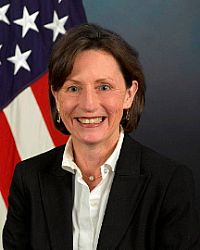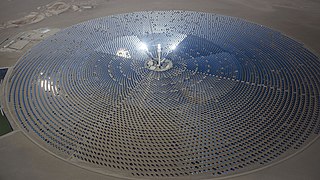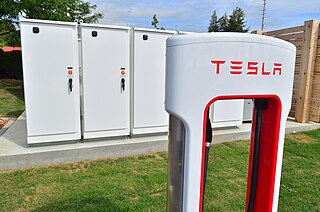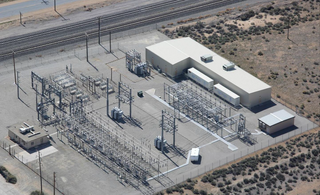Related Research Articles

Southern California Edison (SCE), the largest subsidiary of Edison International, is the primary electric utility company for much of Southern California. It provides 15 million people with electricity across a service territory of approximately 50,000 square miles.

Grid energy storage is a collection of methods used for energy storage on a large scale within an electrical power grid. Electrical energy is stored during times when electricity is plentiful and inexpensive or when demand is low, and later returned to the grid when demand is high, and electricity prices tend to be higher.

Peaking power plants, also known as peaker plants, and occasionally just "peakers", are power plants that generally run only when there is a high demand, known as peak demand, for electricity. Because they supply power only occasionally, the power supplied commands a much higher price per kilowatt hour than base load power. Peak load power plants are dispatched in combination with base load power plants, which supply a dependable and consistent amount of electricity, to meet the minimum demand.

Vehicle-to-grid (V2G) describes a system in which plug-in electric vehicles (PEVs) sell demand response services to the grid. Demand services are either delivering electricity to the grid or reducing the rate of charge from the grid. Demand services reduce the peaks in demand for grid supply, and hence reduce the probability of disruption from load variations. Vehicle-to-load (V2L) and Vehicle-to-vehicle (V2V) are related, but the AC phase is not synchronised with the grid, so the power is only available to "off-grid" load.

FirstEnergy Corp. is an electric utility headquartered in Akron, Ohio. It was established when Ohio Edison merged with Centerior Energy in 1997. Its subsidiaries and affiliates are involved in the distribution, transmission, and generation of electricity, as well as energy management and other energy-related services. Its ten electric utility operating companies comprise one of the United States' largest investor-owned utilities, based on serving 6 million customers within a 65,000-square-mile (170,000 km2) area of Ohio, Pennsylvania, West Virginia, Virginia, Maryland, New Jersey, and New York. Its generation subsidiaries control more than 16,000 megawatts of capacity, and its distribution lines span over 194,000 miles. In 2018, FirstEnergy ranked 219 on the Fortune 500 list of the largest public corporations in the United States by revenue.

NV Energy is a public utility which generates, transmits and distributes electric service in northern and southern Nevada, including the Las Vegas Valley, and provides natural gas service in the Reno–Sparks metropolitan area of northern Nevada. Based in Las Vegas, Nevada, it serves about 1.3 million customers and over 40 million tourists annually.
BrightSource Energy, Inc. is an Oakland, California based, corporation that designs, builds, finances, and operates utility-scale solar power plants. Greentech Media ranked BrightSource as one of the top 10 greentech startups in the world in 2008.
SunEdison, Inc. is a renewable energy company headquartered in the U.S. In addition to developing, building, owning, and operating solar power plants and wind energy plants, it also manufactures high purity polysilicon, monocrystalline silicon ingots, silicon wafers, solar modules, solar energy systems, and solar module racking systems. Originally a silicon-wafer manufacturer established in 1959 as the Monsanto Electronic Materials Company, the company was sold by Monsanto in 1989.
Sunrun Inc. is an American provider of photovoltaic systems and battery energy storage products, primarily for residential customers. The company was established in 2007 and is headquartered in San Francisco, California.

Solar power has been growing rapidly in the U.S. state of California because of high insolation, community support, declining solar costs, and a renewable portfolio standard which requires that 60% of California's electricity come from renewable resources by 2030, with 100% by 2045. Much of this is expected to come from solar power via photovoltaic facilities or concentrated solar power facilities.

The energy sector in Hawaii has rapidly adopted solar power due to the high costs of electricity, and good solar resources, and has one of the highest per capita rates of solar power in the United States. Hawaii's imported energy costs, mostly for imported petroleum and coal, are three to four times higher than the mainland, so Hawaii has motivation to become one of the highest users of solar energy. Hawaii was the first state in the United States to reach grid parity for photovoltaics. Its tropical location provides abundant ambient energy.

Jackalyne Pfannenstiel served as the United States Assistant Secretary of the Navy from March 5, 2010. until her resignation in July 2012.

The Blythe Mesa Solar Power Project, also known as the Blythe Solar Energy Center, is a 235 megawatt (MWAC) photovoltaic power plant near the city of Blythe in Riverside County, California. It occupies about 2,000 acres of public land managed by the Bureau of Land Management in the Mojave Desert. The construction uses CdTe thin film panels from the U.S. firm First Solar, and the majority of the output is being sold to Kaiser Permanente and Southern California Edison under 20-year power purchase agreements.

The Crescent Dunes Solar Energy Project is a solar thermal power project with an installed capacity of 110 megawatt (MW) and 1.1 gigawatt-hours of energy storage located near Tonopah, about 190 miles (310 km) northwest of Las Vegas. Crescent Dunes is the first commercial concentrated solar power (CSP) plant with a central receiver tower and advanced molten salt energy storage technology at full scale, following the experimental Solar Two and Gemasolar in Spain at 50 MW. As of 2023, it is operated by its new owner; ACS, and in a new contract with NV Energy, it now supplies solar energy at night only, drawing on thermal energy stored each day.

Anbaric Development Partners (Anbaric) is an American electric power transmission and storage development company located in Wakefield, Massachusetts. The company develops smart grid, renewable energy, and large-scale electric transmission projects which use high-voltage direct current (HVDC) technology for clients in the United States and internationally.

The Tesla Powerpack was a rechargeable lithium-ion battery stationary energy storage product, intended for use by businesses or on smaller projects from power utilities. The device was manufactured by Tesla Energy, the clean energy subsidiary of Tesla, Inc. The Powerpack stores electricity for time of use load shifting, backup power, demand response, microgrids, renewable energy integration, frequency regulation, and voltage control. The first prototype Powerpacks were installed in 2012 at the locations of a few industrial customers. After July 22, 2022, the product was no longer listed for sale.
Younicos was a German-American technology company that developed and sold energy storage systems and control software. The company integrated battery technologies, power electronics and control software to create systems that respond to the energy management requirements of power networks of all sizes, including micro-grids.

The Tesla Megapack is a large-scale rechargeable lithium-ion battery stationary energy storage product, intended for use at battery storage power stations, manufactured by Tesla Energy, the energy subsidiary of Tesla, Inc.

The Tehachapi Energy Storage Project (TSP) is a 8MW/32MWh lithium-ion battery-based grid energy storage system at the Monolith Substation of Southern California Edison (SCE) in Tehachapi, California, sufficient to power between 1,600 and 2,400 homes for four hours. At the time of commissioning in 2014, it was the largest lithium-ion battery system operating in North America and one of the largest in the world. TSP is considered to be a modern-day energy storage pioneer with significant accomplishments that have proven the viability of utility-scale energy storage using lithium-ion technology. While originally envisioned as a research and development project, TSP operated as a distribution-level resource for SCE and for calendar year 2020, SCE reported that TSP operated in the wholesale energy market with revenue exceeding operating and maintenance costs. In 2021, SCE began the decommissioning of TSP, which was followed by formal decommissioning by state regulators in 2022. The physical dismantlement of TSP is expected to be completed by the end of 2022.
References
- ↑ St. John, Jeff (20 June 2012). "Ice Energy Finds Profits in Thermal Energy Storage". Greentech Grid. Greentech Media, Inc. Retrieved 8 January 2015.
- ↑ Cordner, Christine (14 November 2014). "SoCalEd's energy storage winners say RFO results legitimize the resource". SNL. SNL Financial LC. Retrieved 8 January 2015.
- ↑ Wald, Matthew (21 December 2014). "Energy-Storage Plans Gain Ground in California". The New York Times. Retrieved 21 January 2015.
- ↑ St. John, Jeff. "SCE Chooses Ice Energy for 25MW of Rooftop Thermal Energy Storage". Greentech Grid. Greentech Media, Inc. Retrieved 19 January 2015.
- ↑ Handova, Derek. "Ice Tech Enables Time-Shifting for Single-Family House Cooling". Medium. Retrieved 22 January 2015.
- ↑ Richardson, Jake (22 November 2014). "25 MW Of Ice Energy Storage For Southern California Edison". Clean Technica. Sustainable Enterprises Media, Inc. Retrieved 30 December 2014.
- ↑ Welter, Ben. "Ice Energy lands 16 contracts with Southern California Edison". PureTemp. Entropy Solutions, LLC. Archived from the original on 12 January 2015. Retrieved 12 January 2015.
- ↑ Trabish, Herman. "Big storage procurements leave more questions than answers". Utility Dive. Industry Dive. Retrieved 20 January 2015.
- ↑ "Ice Energy Holdings, Inc. Bankruptcy (8:19-bk-14865), California Central Bankruptcy Court". www.pacermonitor.com. Retrieved 2019-12-30.